Interlude in Japan
Tagged:Beauty
/
CatBlogging
/
Food
/
Politics
/
Retirement
/
ϜΤΦ
While the US Republicans were busy excreting a fascist into power, we had a trip to Japan to visit family. I took too many pictures, mostly of grocery stores and food.
Why? And What About the Publishers?!
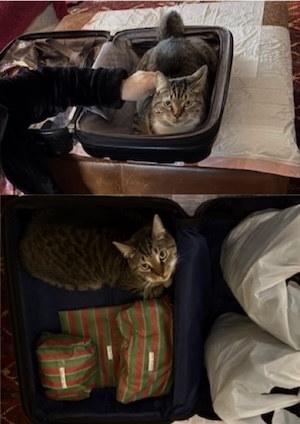 Well, because the Weekend Editrix is Japanese, of course! Also, her elderly mother
requires considerable care, and we want to maximize the chances to see her while she’s
still here. So it was mostly a trip to take care of her for a few weeks.
Well, because the Weekend Editrix is Japanese, of course! Also, her elderly mother
requires considerable care, and we want to maximize the chances to see her while she’s
still here. So it was mostly a trip to take care of her for a few weeks.
The Weekend Editrix went first for 2 weeks, and was then joined by your humble Weekend Editor.
As you can see here, the Assistant Weekend Publisher was eager to attempt to join both trips! (The Weekend Publisher is, of course, himself too dignified for such antics.) However, both boys were content with the cat-sitter we got to come over and sleep with them at nights.
Of course, any such change in the presence of senior members of the tribe will lead to dominance struggles.
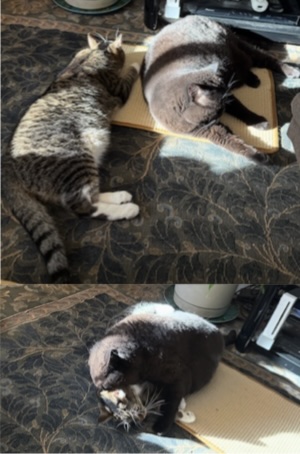 Here we see the Assistant Weekend Publisher about to lie down
peacefully behind his sempai. However, his lack of good manners led him to attempt a
play attack… which, as you can see, led to his being steamrolled by that sempai, who
is twice his size and half his patience.
Here we see the Assistant Weekend Publisher about to lie down
peacefully behind his sempai. However, his lack of good manners led him to attempt a
play attack… which, as you can see, led to his being steamrolled by that sempai, who
is twice his size and half his patience.
The little guy never seems to learn from this, so we think he maybe likes it? The big guy is exasperated beyond belief at this. Exasperation is, of course, the natural state of older brothers. He didn’t ask for this, but he’s coping with the imposition of a younger ‘brother’ as best he can. At times, his ‘best’ involves swatting the little guy across the room like a hockey puck.
Of course, no visit this time of year is complete without gifts. So we got our mother some nice warm slippers, a Deadpool/Wolverine comic for a nephew, and so on.
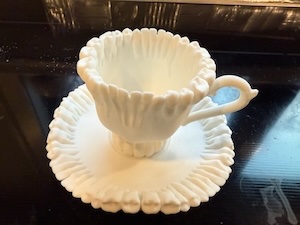 “And so on”, as used here, means I had this cup 3d-printed as a joke gift for my
brother-in-law, who is a dentist in Japan. I happened across the
“And so on”, as used here, means I had this cup 3d-printed as a joke gift for my
brother-in-law, who is a dentist in Japan. I happened across the .stl files somewhere on
the internet, for no obvious reason. It turns out there are 3d printing houses which will
do one of these for only a few 10s of dollars, so… here it is.
I don’t know if it’s food-grade or not, but somehow I don’t think anyone’s in danger of putting it into regular use.
I wonder if it will be as funny to him as it is to me?
Some Personal Memories Remain the Same
 As we remarked on a previous excursion to Japan,
sometimes the smallest little detail can spark a long train of thought. In this case, a
covered walkway at a train station/shopping plaza near my mother-in-law’s house never
fails to make me think of conformal mapping in the complex plane. This one’s a variant
Schwarz-Christoffel transform,
realized in glass. Cooler if the arch were wing-shaped and this were a
Joukowski transform, but still pretty
cool.
As we remarked on a previous excursion to Japan,
sometimes the smallest little detail can spark a long train of thought. In this case, a
covered walkway at a train station/shopping plaza near my mother-in-law’s house never
fails to make me think of conformal mapping in the complex plane. This one’s a variant
Schwarz-Christoffel transform,
realized in glass. Cooler if the arch were wing-shaped and this were a
Joukowski transform, but still pretty
cool.
Yes, this is pareidolia. But it’s my pareidolia.
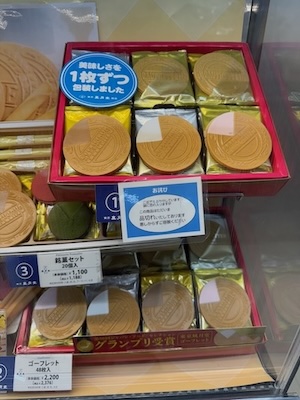 These are some Japanese cookies called gofuru, apparently derived from ‘gauffre’
(except those are more like Belgian waffles). They’re extremely thin wafer cookies,
sandwiching a very thin layer of various flavors.
These are some Japanese cookies called gofuru, apparently derived from ‘gauffre’
(except those are more like Belgian waffles). They’re extremely thin wafer cookies,
sandwiching a very thin layer of various flavors.
They always catch my eye, because I used to bring them back as souvenirs for a friend who loved them. That friend is now no longer with us, a victim of depression. But every time I see gofuru, I think ‘Hey, I should get some for…’ and then remember he’s gone.
It’s sad to feel his absence, but it’s good to remember people, especially for the good they did with their lives. While I hope the best for him in a religious sense, I also remember the good he did here, with his relentless kindness and good humor.
And, yeah… I get momentary tears in my eyes when seeing gofuru.
Miss you, buddy.
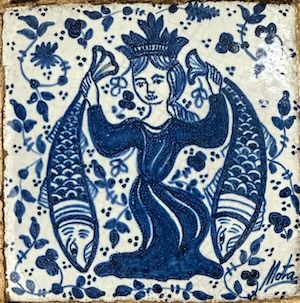 This is a decorative tile displayed on a wall of my mother-in-law’s house. My
father-in-law, alas now also departed, collected lots of little bits of art and oddball antiquery
like this. It depicts a floral background, with a crowned woman in medieval-ish dress in
the foreground, holding 2 fishes by their tails.
This is a decorative tile displayed on a wall of my mother-in-law’s house. My
father-in-law, alas now also departed, collected lots of little bits of art and oddball antiquery
like this. It depicts a floral background, with a crowned woman in medieval-ish dress in
the foreground, holding 2 fishes by their tails.
It’s always puzzled me: it clearly means something, probably related to some myth or well-known tale. I know a lot of such tales, but this one evades me. Initially, I though it might be the source of the Starbuck’s logo, but that turns out to be a crowned mermaid with 2 tails (holding up a tail in each hand). I can find some other partial matches with Google Lens, always in cobalt blue on tile, and always unexplained.
I’d really appreciate it if anybody could scratch my curiosity bump and tell me what this thing is! Probably something obvious that will embarrass me for not knowing, but I really do want to know or at least be reminded.
Some Other Memories Are the Same, But Always Surprising
No matter how often you see some things, they can always surprise you.
My Slightly Morbid Fascination with Grocery Stores
I have a slightly morbid fascination with grocery stores. I’ve always been a depressed & anxious guy, and so I worry about social collapses and sudden shortages of food, clean water, sewage processing, electricity, and… civil order. A professor once made an impression upon me (many times, actually) in a history of science course: if you stop the food trucks coming into the city, the warehouses empty out in about 3 days and food riots begin about 3 days after that.
So ever since then, I’ve been fascinated with looking through grocery stores. Yup, food’s still here. Anarchy is at least a week away. (At least, hunger-driven anarchy.)
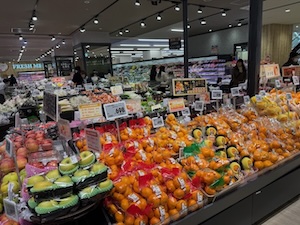 Japanese grocery stores are quite reassuring in that regard: large, well-lit, possessing a
wide variety of foods, somewhat reasonable prices (though the yen/dollar exchange rate has
some influence on my thoughts there). This is a mid-range grocery store, not even one of
the really special ones, and it’s beautiful.
Japanese grocery stores are quite reassuring in that regard: large, well-lit, possessing a
wide variety of foods, somewhat reasonable prices (though the yen/dollar exchange rate has
some influence on my thoughts there). This is a mid-range grocery store, not even one of
the really special ones, and it’s beautiful.
The variety of produce is always pretty good. Most amazingly, from a foreigner’s perspective, there are a variety of fresh fish… but the cleanliness is so scrupulous that it doesn’t smell bad. (In the US, fish specialty shops in particular smell so awful I just can’t go in.)
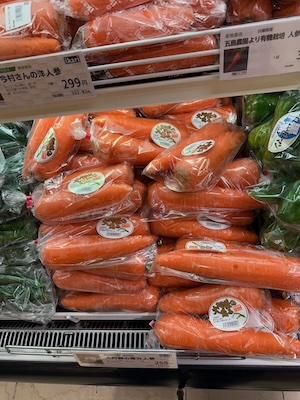 Also, for no particularly obvious reason, I’m fascinated by Japanese carrots. Look at these
thick monsters! They’re not quite as thick as my wrist, but almost. I daydream about
making a really nice stew with thick chunks of carrot, cooked slowly.
Also, for no particularly obvious reason, I’m fascinated by Japanese carrots. Look at these
thick monsters! They’re not quite as thick as my wrist, but almost. I daydream about
making a really nice stew with thick chunks of carrot, cooked slowly.
I wonder if the taste or texture changes when they get that thick? A lot of Japanese food plants have been bred extensively to achieve a taste preferred by consumers, so I bet they’re really good, as well as giant.
Also, given my status as an illiterate and unsophisticated barbarian at the best of times in Japan, there’s probably some tradition or story around thick carrots of which I remain unaware. The experience of being a yabanjin is an uncomfortable one, but it makes me go to great efforts to be polite and respectful.
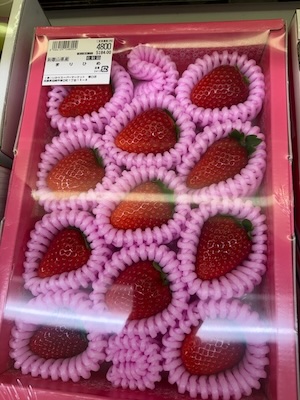 Japanese strawberries in particular have been highly bred to have a sweet flavor.
Strawberries in the US are a bit of a roll of the dice: they might be nice, or they might
be almost inedibly sour. When I was a kid, we always put sugar on them (but then again,
that was the 1950s and 1960s, when everybody did that). Japanese strawberries, or even
those bought in the US through a Japanese grocer, are always sweet and have a vibrant
fruit taste stronger than the sweetness.
Japanese strawberries in particular have been highly bred to have a sweet flavor.
Strawberries in the US are a bit of a roll of the dice: they might be nice, or they might
be almost inedibly sour. When I was a kid, we always put sugar on them (but then again,
that was the 1950s and 1960s, when everybody did that). Japanese strawberries, or even
those bought in the US through a Japanese grocer, are always sweet and have a vibrant
fruit taste stronger than the sweetness.
There’s a tradition of making seasonal gifts of fruit, with some kind of complex rules about going up and down the social status ladder. These gifts must be absolutely perfect fruits, so sometimes you’ll see a beautiful cantaloupe with artful decorations for something equivalent to $100. Here we see a presentation box of strawberries, each carefully cushioned to avoid bruising, that sells for about 4800 yen or about $31. For just 11 strawberries, that’s just under $3/strawberry!
But of course more ordinary strawberries just for eating are priced more ordinarily. What you’re seeing here is more about social custom than about fruit!
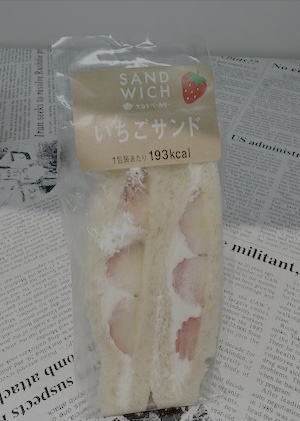 Alas, my dark side offers the opinion that sometimes, some people just shouldn’t have
strawberries. Why so grim? Read on; some foods are temptations to the dark side of
culinary life.
Alas, my dark side offers the opinion that sometimes, some people just shouldn’t have
strawberries. Why so grim? Read on; some foods are temptations to the dark side of
culinary life.
Case in point: Here’s a currently popular ‘sandwich’ snack: white bread (usually shokupan, a soft white milky bread), whipped cream, and strawberries. The display, inscrutably placed atop English-language newsprint, helpfully informs us that this will only cost us 193kcal, which is less than I thought.
I don’t quite get the target customer population here, unless it’s middle school kids hungry after school to go on a sugar rage. That doesn’t seem quite in line with cultural expectations, but what does a neurodivergent old nerd like me know?
And note the display: this was the last one left! It’s not like they don’t sell.
But the pathology runs deeper: this short video tells the tale of a ‘snack’ at a store in Tokyo called Age 3 (“ah-geh-san”, with a hard g and 3 is pronounced “san”; not “age 3” as we would say of a toddler in English!).
They make – and apparently sell – a white bread and whipped cream sandwich that has been, somehow, fried. Possibly deep-fried. They also sell a lot of other ‘sandwiches’ along similar lines, e.g., crème brûlée.
Now, I almost get this one better than the previous one. I mean, if you’re gonna go for some insanely indulgent, artery-clogging, type 2 diabetes-inducing dessert, you might as well do something absurd. If you’re gonna lose your grip on reality, you may as well let go with both hands.
The Scalzi schadenfreude pie comes to mind as an American example. Though that was irony, not a business model. This… seems to be devious temptation and a brilliant loss leader.
Pastry!
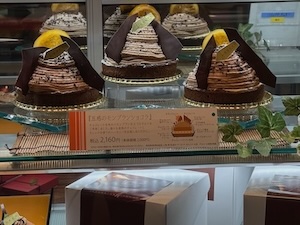 Yes, I have a weakness for pastry. (Did you notice how gently I treated the fried cream
sandwich above?)
Yes, I have a weakness for pastry. (Did you notice how gently I treated the fried cream
sandwich above?)
Japanese pastry comes in several varieties, but mostly they’re traditional Japanese (e.g., various kinds of mochi, a rice paste) or derived from European cultures. Their flair for French pastry is as good as, or better, than I’ve had in Paris.
Here’s a picture of a Mont Blanc pastry on sale in a depato, or department store. It’s basically a super-duper cream puff base with various layers of crème pâtissière and topped with a chocolate and a chestnut purée piped to look like vermicelli.
But click on the picture to see it full size: there’s also what looks like an engineering sectional diagram, or a frontal elevation diagram. It tells you, very precisely, what’s inside, where it is, and how much of it you’re going to encounter.
Very, very difficult for a nerdy pastry fan to resist! (Fortunately, the Weekend Editrix yanked on my arm after I took this photo and prevented me from doing anything too foolish, like buying half a dozen.)
The Art of the Bento Box
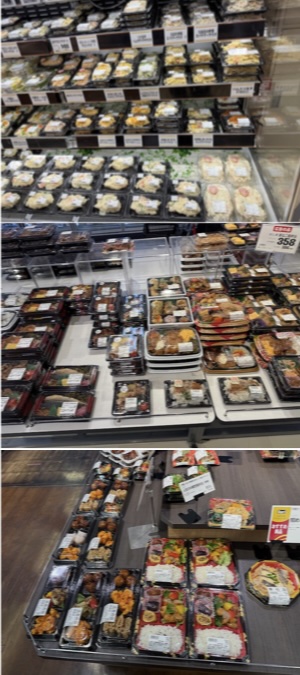 Usually people translate bento as “box lunch”. That’s about as accurate as translating
kimono as “robe”: technically correct, but losing all relevant meaning. Japanese bento lunches
are extraordinarily artfully assembled selections of 5-10 different dishes, sometimes in a
plastic box but sometimes in a beautiful lacquer box.
Usually people translate bento as “box lunch”. That’s about as accurate as translating
kimono as “robe”: technically correct, but losing all relevant meaning. Japanese bento lunches
are extraordinarily artfully assembled selections of 5-10 different dishes, sometimes in a
plastic box but sometimes in a beautiful lacquer box.
This is one of those things that strikes me as extraordinary, but Japanese just shrug and wonder why I’m so entranced with lunch.
There are lots of such moments. For example, once we were looking at a Buddhist temple in Kyoto. (I always have awkward feelings about “touring” in other people’s sacred space. Especially so when they’re actively using it, and I really don’t want to be a disturbance!) But in the middle of a beautiful garden was a little orange-roofed thing the size of a dog-house. It was, in fact, a Shinto shrine. In the middle of a Buddhist temple garden. This is ecumenism at a professional level! And every Japanese to whom I tell this story, just shrugs as if to say “So what?” (So this: imagine if a Mormon temple had a Catholic shrine in its gardens. Wouldn’t you want to know the story?)
Here’s a selection of ordinary bento boxes from pretty ordinary grocery stores across a range of prices. (Click through to see the full-size triptych.) They’re all pretty cheap, like you could eat one for lunch every day and never feel an economic loss, or nutritional deficit, or weight gain.
They’re cheap, tasty, nutritious, and widely available. My dream is that everybody in the world should have access to high-quality food like that!
What exactly is stopping us? Just a Gini index pointing at oligarchs who soak up all the wealth to make everything else impossible? (Well, that suggests a strategy, no?)
The Naming of Stores
No trip would be complete without an expedition to a Japanese mall. The Weekend Editrix sought some clothes that were fitted for Japanese-sized bodies, and a Japanese sense of style. And so, a short train trip – don’t get me started on how much I love the trains in Japan, or we’ll be here for years – to a mall in Nishinomia. Japanese shopping malls, unlike those in the US, are not dying relics of a forgotten age. This is a nice mall, but not particularly fancy.
So I did what most husbands did while waiting on spousal clothing selection: I walked around and looked for something interesting. What was interesting here was the naming of stores, many of which inexplicably display their inexplicable names in English. I appreciate that marketing people think the choice of names is crucial, but I didn’t expect it to rise to TS Eliot levels (unless every store has a secret name that only the store knows):
The Naming of Cats is a difficult matter,
It isn’t just one of your holiday games;
You may think at first I’m as mad as a hatter
When I tell you, a cat must have THREE DIFFERENT NAMES. …
— Opening lines of TS Eliot’s, “The Naming of Cats”, Old Possum’s Book of Practical Cats, 1939.
 Here are a selection of stores whose English names are evocative, if puzzling. (Click
through to see the full-size image.)
Here are a selection of stores whose English names are evocative, if puzzling. (Click
through to see the full-size image.)
- “UNIVERSAL LANGUAGE MEASURE’S” has a wayward apostrophe, but seems to be about men’s clothing. Perhaps “measure” implies custom tailoring?
- “CIAOPANIC TYPY™” seems eager to overcome the nonsense of the name to remind us that it’s trademarked nonsense. I didn’t panic. Nor did a pretend to be Italian and say “ciao”. No idea what “typy” means, so not sure if I did that or not.
- “RAGEBLUE” was neither especially blue nor particularly rage-inducing.
- “Innocent Individuality” made me ponder whether, in a culture with such strong group identity, individuality was by default suspect and not especially innocent? If so, the store seeks to reassure us that their individuality is of the better sort?
- “mysty woman” is beyond me. I don’t know the word “mysty”, since it is somewhat existence-impaired. I do know the word “woman”, but know better than to think I understand women. So I walked carefully around this one.
- “w closet” seems like an apt commentary on the George W Bush administration, but that could be my desire to spit venom in the general direction of all things Republican.
- “AMERICAN HOLIC” made me think. “Holic”, of course, from alcoholic, denotes addiction. But does this mean a store for Japanese addicted – for some reason – to American culture? Or does it mean Americans are generally addicted to a lot of stuff, hence our problems with obesity, drugs, guns, and money? A worthy question!
- “AS KNOW AS PINKY” is… well, not especially pink. No idea if ‘Pinky’ is a person, or somebody’s pet fish, or…
- “SENSHU TOWEL” is, of course a towel store. It’s not on this list because it has a peculiar name, but rather the opposite: it’s just a sensible description. What struck me, though, was the subtitle “since 1887”. How many businesses have been in business for 138 years with such a narrowly specialized product line? Are these guys just business geniuses, or are the towels extraordinarily good, or am I hallucinating? All viable hypotheses.
Food!
So, we went out to dinner a couple times. Mostly, we wanted to get Mama-san out and engaging the world, but also we wanted to enjoy some Japanese restaurants.
Now, usually people mean something specific by “Japanese restaurants” in terms of the food and the style of preparation & presentation. Here, though, we just mean “restaurant that happens to be in Japan”. Somebody asked the Weekend Editrix what foods she’d want to try first when she got back to Japan. Her answer was the French/Italian place in her neighborhood that was extremely high quality in both French and Italian styles. Not… a typical Japanese answer, eh?
Coquina Quattuor Foliumu
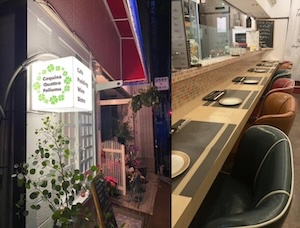 As it turned out, her favorite place had recently closed up business. However, the chef
opened his own new place nearby, so that’s where we went first.
As it turned out, her favorite place had recently closed up business. However, the chef
opened his own new place nearby, so that’s where we went first.
It’s named Coquina Quattuor Foliumu.
This is alleged to be “Kitchen Four Leaves” in Latin, as evidenced by the lucky 4-leaved clovers on their sign. However, this is a slightly odd word choice according to my inner Latin hacker: “culina quattuor folia” would have been my first stab at it. Still, Google Translate seems to agree with the meaning. Amusingly, on some of their marketing materials – like a business card I appear to have lost – it says “Quattro” instead of “Quattuor”. Viewed from the starting point of Japanese language, I guess Latin, Italian, and Spanish are all pretty close. (They panicked for a few seconds when I mentioned this to the Weekend Editrix, but I think all is well. That’s my neurodivergent inner nerd, who sometimes blurts things out when they pop up. Apologies if I should have kept my mouth shut.)
Since they’re quite new, they don’t seem to have a web site. The link above goes to a local news publication, and is the source of the pictures here.
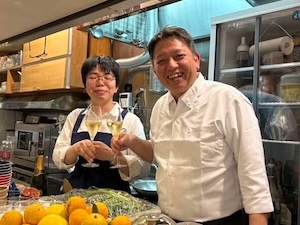 It’s also a tiny place, as you an see here – only 6 seats!
It’s also a tiny place, as you an see here – only 6 seats!
Also, it’s slightly reminiscent of the experience at a sushi bar, where one sits at a counter and watches the chef. It’s staffed by 2 people: the chef and a waiter, both shown here. The chef is quite the showman: he engages his guests in humorous conversation while preparing all their dishes simultaneously. Imagine a comedian, an interviewer, and a juggler all at the same time, and you’ll get the flavor.
The food was excellent, though I forgot to take pictures (alas; you can blame me, but I blame jet lag). The price was amazing: we fed 3 people a multi-course French meal (though without wine) for just around $100. The favorable dollar/yen exchange rate helped, but restaurants in Japan are not as usuriously expensive as in the US recently.
Definitely worth the trip.
French Grill Angélique
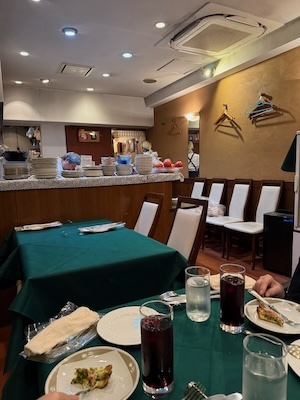 Another place the Weekend Editrix and Mama-san wanted to try was a nearby one, called
Angélique.
In fact it was so nearby, we could just walk for 10 minutes. I acted as wheelchair
pilot for Mama-san, which is something I oddly enjoy even with my cane.
Another place the Weekend Editrix and Mama-san wanted to try was a nearby one, called
Angélique.
In fact it was so nearby, we could just walk for 10 minutes. I acted as wheelchair
pilot for Mama-san, which is something I oddly enjoy even with my cane.
The outside was… unprepossessing. It’s just a little carve-out below some apartments, next to a garage and a convenience store. The inside, as you can see here, is comfortable though small (only 3 tables).
The chef is off to the side, instead of on display in front of you, but still observable. The tiny size of these restaurants means the service is always very personal. (I’m a little anxious about personal attention from strangers, again my non-NT side insisting on squirming a bit. Most people will love it.)
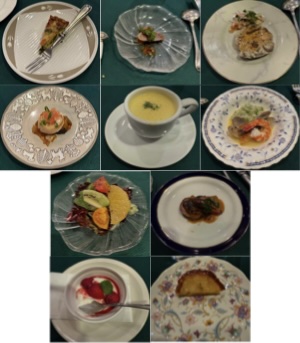 We had a prix fixe dinner of 10 plates, shown here. My memory’s gotten a bit vague, but
working left-to-right/top-to-bottom: a bit of quiche, some seared tuna, a mushroom
pâté, a scallop, a soup probably of squash, a shrimp/mussels/risotto, a salad with
brilliantly bright mikan and kiwi, some beef with either a red wine sauce or
demi-glace (the latter is available in, it seems, every Japanese grocery store; in the
US it’s a specialty item so we pull tricks like this),
and 2 small desserts: something like a blanc-mange with berries and a tiny apple tart.
We had a prix fixe dinner of 10 plates, shown here. My memory’s gotten a bit vague, but
working left-to-right/top-to-bottom: a bit of quiche, some seared tuna, a mushroom
pâté, a scallop, a soup probably of squash, a shrimp/mussels/risotto, a salad with
brilliantly bright mikan and kiwi, some beef with either a red wine sauce or
demi-glace (the latter is available in, it seems, every Japanese grocery store; in the
US it’s a specialty item so we pull tricks like this),
and 2 small desserts: something like a blanc-mange with berries and a tiny apple tart.
Everything was lovely. Again, the price was extremely reasonable: 3 people for under about $130 at current exchange rates. But… cash only! (That could have been embarrassing!)
The Weekend Conclusion
This post is titled “interlude” for good reason: Latin inter + ludos, between games or lessons. (Some wily ancient Roman magister/teacher conned students into thinking the word was the same for “lesson” and “game”!)
It was a time full of travel stress, jet lag, and seeing family we both love. But it was also the very weird feeling of illiteracy for me. I’m used to being able to read signs in several languages, knowing the etymology of all the words, the literary and mythological references, and so on. To be dumped into another culture, at least as complicated as all of western Europe taken together was to bathe in a sea of ignorance. It’s quite a lesson in humility when everything is complicated & different.
But… that’s where family live, and there’s beauty to be found all around you. Even if, compared to usual tourist preferences, you think my choices are ‘eccentric’.
That being said, we had to return to the US. We came back on Jan 20 in the evening, about 8 hours after FFOTUS (First Felon of the United States), as he is now widely called, was installed.
I was really worried about being hassled at the border. But we had prepared: I had a brand-new US passport, the Weekend Editrix had a brand-new Japanese passport and a brand-new US green card. Our luggage was squeaky clean for customs, and we had a long history of being harmless elderly PhD nerds. (In the case of the Weekend Editrix, her membership in the Nerd Tribe is largely honorary, as she is possessed of excellent social skills.)
As it turns out: both entering Japan and re-entering the US, border folks saw my cane and diverted us to a different line. In the US, this turned out to be, of all things, the diplomatic line. So we got an agent who was reasonably cooperative, if understandably taciturn. I could hear, though, other agents somewhat belligerently questioning people in the other lines about their place of living, jobs, and so on.
It was quite a shock to have to face the reality of returning to a country rapidly turning fascist, run by oligarchs for oligarchs. PoliticsGirl has it summed up accurately in this video: the norms are gone so don’t pretend normality; instead the job of Democrats (and everyone, really) is to obstruct everything.
It literally sickens me – as in, actual vomiting – to see Democrats behaving helplessly and established media like The New York Times uselessly trying to ‘find the center’. With an opponent who denies your right to exist and opposes democracy at all, there is no center; there is only a fight.
Japan was better, at least in that regard.
(Ceterum censeo, Trump incarcerandam esse.)
Notes & References
Nope.

Gestae Commentaria
Comments for this post are closed pending repair of the comment system, but the Email/Twitter/Mastodon icons at page-top always work.